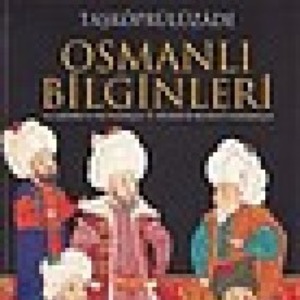
Scholar
of kalam, fiqh and tafsir, calligraphist. He wass the author of “Şekâiku’n Nu’maniyye”a well-known encyclopaedia
(B. 2nd December 1495,
Taşköprülüzade was appointed to Oruç Paşa Madrasah in Didymoteicho in
1525, and to Hacı Hasan Madrasah as a lecturer. Upon his father’s death (1529),
he was appointed to Üsküp Alaca Ishak Bey (1530) and İstanbul Kalenerhane
(1536) madrasahs. He showed a very good progress in his profession and became a
professor at prestigious madrasahs like Koca Mustafa Paşa, Sahn-ı Semân, Edirne
Üç Şerefeli, Edirne Sultan Bayezit (1544). In 1545 he was appointed as Kadi (T.N.
Islamic judge) of
Ahmet
Efendi was the author of numerous books about kalam (explanation of principles
of faith by rational reasoning), fiqh (Islamic Law) tafsir (interpretation of
Qur’an), morals, logic, biography, Arabic language and literature, history of
science, medicine and of nearly thirty risalahs (booklets). He wrote his books
in Arabic and maintained the tradition of şerh (exegesis) and haşiye (annotation).
He discussed theology on the basis of the ideas of scholars who were members of
Eş’ariyye (a widespread branch, second only to Maturidi) like Fahreddin
er-Râzî, Seyfeddin el-Âmidî, Seyyid Şerif el-Cürcânî but he still remained in
Maturidi. It is conspicuous that he regarded Maturiddi as the founder of kalam
Taşköprülüzade
Ahmed Efendi was famous for his works on history of science and biographies as
long as he was a religious scholar. Particularly, his encyclopedia work “Şekâ’iku’n-Nu’mâniyye”, which gives information about scholars of Ottoman
Empire, and his work “Miftâhu’s-Saâde” which was about history are one of the most important
and most known works of him. Taşköprülüzade showed interest also in Sufism and
joined Khalwati Order thus representing an eclectic scholar who combined
philosophy, kalam and Sufism. Besides, he was a calligraphist who was an expert
on thuluth, naskh and ta’liq and he spent the money he earned from calligraphy
for his students. There are many post graduate theses, doctorate theses and
associate professorship theses on Taşköprülüzade Ahmed Efendi.
The most well-known
work of Taşköprülüzade is “el-Şekâik
el-Numaniyye fî ulemâ el-devlet el-osmaniyye”, which he began to write at
the age of 63 after four years in professorship and five years in judgeship
(1588) and which was about biographies of scholars and sheiks of Ottoman Empire
from the foundation of the empire until the reign of Sultan Suleiman the Magnificent
(1566). Ahmed Efendi was aware that the number of scholars and sheiks he didn’t
mention in his book was much more than those he mentioned. He basically mentioned
scholars and sheiks who were important people in Association of Scholars of
Ottoman and who were followers of Davud el-Kayserî - Molla Fenârî - Ali Kuşçu -
Mirim Çelebi whom he himself was follower of, too in his book. Within this
framework, he recorded 521 people, 150 of whom were sheiks and 371 of whom were
scholars and who lived in a period of a particular king in 10 categories.
Şekaik was
translated into Turkish by many people like Aşık Çelebi (died in 1572),
Belgradlı Muhtesib-zâde Mehmed Hâkî Efendi (died in 1567) and Amasyalı İbrahim
b. Ahmed after Taşaköprülüzade had passed away. The best translated version of
it was Hadâk el-şekâik by Edirneli Mehmed Mecdi Efendi who gave additional
information in it. Thus, Şekâik of Ahmed Efendi was a starting point for many
works on the biographies of scholars, sheiks and poets of
Şekâik was
translated into German by O. Rescher in 1927. In 1975 it was published in
WORKS:
Miftâhu s-Saâde ve
Misbâhu’s-Siyâde fî Mevzûâti'l-Ulûm (encyclopedia and bibliographical work about history
of science and classification, Haydarâbâd 1328-1329), eş-Şe kâiku n-Numâniyye fî Ulemâ-i’d-
Devleti’l-‘Osmâniyye (Published
by: Ahmet Suphi Furat, Istanbul 1985),
Nevâdirü’l-Ahbâr fî Menâkıbi’l- Ahyâr, el-Meâlim
fî İlmi’l-kelâm, Risale
fi’l- Kazâ ve’l-Kader (Published by Muhammed Zâhid Cûl, Cologne
2008), Haşiye alâ Hâşiyeti’s-Seyyid
eş-Şerîî alâ Şerhi’t-Tecrîd, Ecellü’l- Mevâhib fî Marifeti Vücûdi’l- Vâcib,
Letâ’ifü’n-Nebî, Risale fî Beyâni
Esrâri’l-Hilâfeti’l-in- Sâniyye ve’s-Saltanati’1-Maneviyye,
Hâşiye calâ Hâşiyeti’l- Keşşâf li’s-Seyyid eş-Şerîî el-Cürcânî,
Şerhu Mukaddimeti’l-Ce zerî (Mecca 1303), Şerh calâ
Risale fî cilmi âdâ- bi’l-bahş ve’l-Münâzara (Published
by Muhammed Hasan Âl-i Yâsîn, Istanbul 1299),
Şerhu Dîbâceti’l-Hidâye, Şerhu’l-Ferâ’iz, Şerhu Mukaddime ti’s- Salât, Şerhu’l-Ahlâkı’l-‘Adudiye,
Münyetü’ş-Şübbân fî Muâşereti’n-Nisvân, Şerhu’l-Avâmili’lmiye, Şerhu’l-Fevâ’idi’l- Gıyâşiyye
fî İlmeyi’l-Meânî ve’l-Beyân, Risâletü’ş-Şifâ
fî Edvâ’i’l-Vebâ (Cairo 1292).
REFERENCE: İbrahim Alaeddin Gövsa / “Taşköprülüzade Ahmet Efendi” (Türk Meşhurları, 1946), Cihat Tunç / “Taşköprülüzâde Ahmet Efendi’ye Göre Kelâm İlminin Yeri ve Önemi” (1992), Murtaza Korlaelçi / “Taşköprülüzâde ve Kâtip Çelebi'ye Göre Türk Kültüründe Felsefe’nin Yeri” (Felsefe Dünyası, sayı: 7, 1993), Cevat İzgi / Osmanlı Medreselerinde İlim (1997, c. I, s. 69-77), İhsan Fazlıoğlu / “Ahmed Efendi (Taşköprülüzâde)” (YYO Ansiklopedisi, c. I, 1999, s. 122-124), Yusuf Şevki yavuz / “Taşköprîzâde Ahmed Efendi” (TDV İslam Ansiklopedisi, c. 40, s. 151-152, 2011), İhsan Işık / Resimli ve Metin Örnekli Türkiye Edebiyatçılar ve Kültür Adamları Ansiklopedisi (2006, 2007) - ) - Encyclopedia of Turkey’s Famous People (2013).